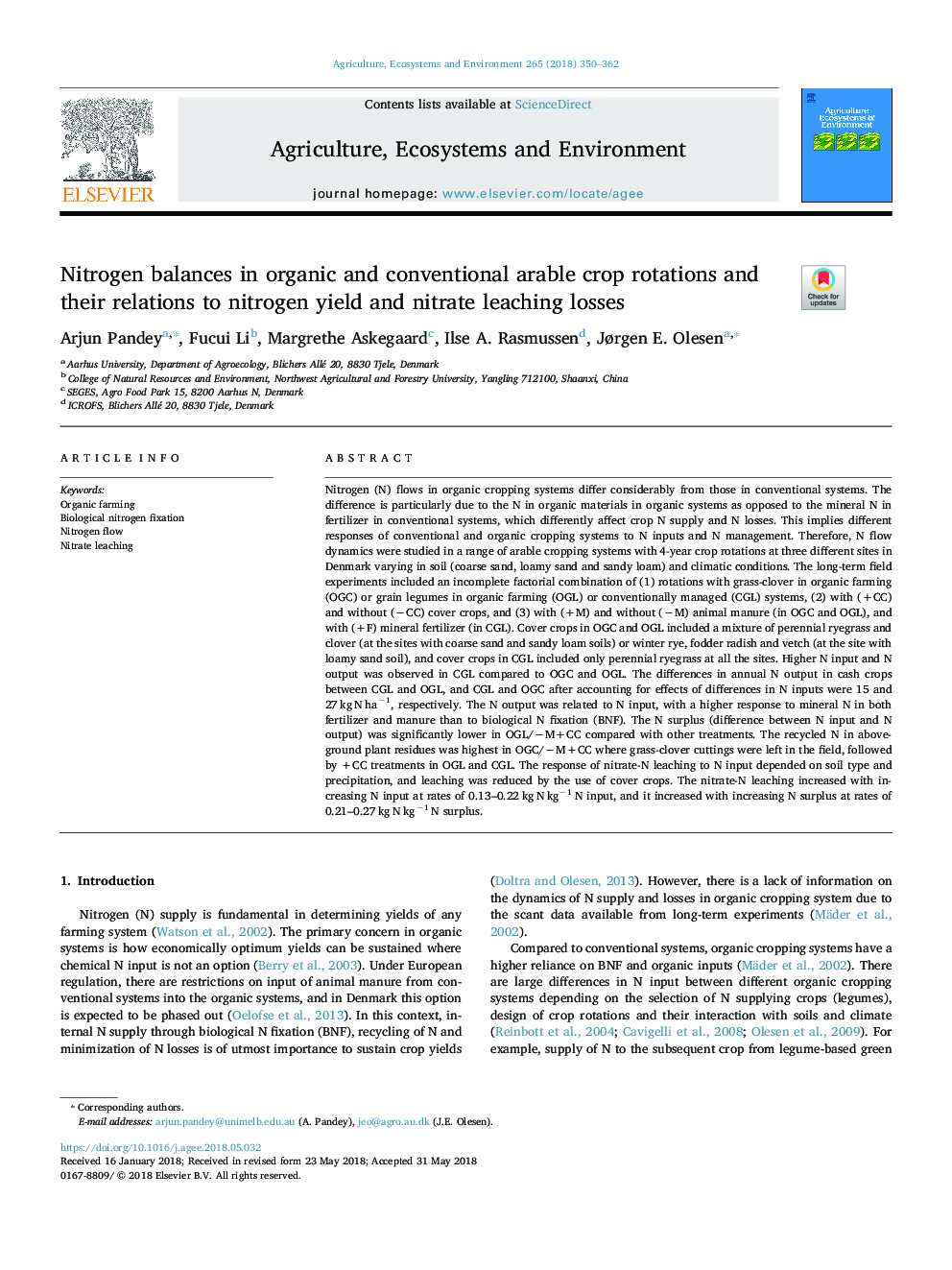| کد مقاله | کد نشریه | سال انتشار | مقاله انگلیسی | نسخه تمام متن |
|---|---|---|---|---|
| 8486991 | 1551987 | 2018 | 13 صفحه PDF | دانلود رایگان |
عنوان انگلیسی مقاله ISI
Nitrogen balances in organic and conventional arable crop rotations and their relations to nitrogen yield and nitrate leaching losses
ترجمه فارسی عنوان
تعادل نیتروژن در گیاهان زراعی آلی و متعارف و روابط آنها با عملکرد نیتروژن و تلفات نیترات لیتینگ
دانلود مقاله + سفارش ترجمه
دانلود مقاله ISI انگلیسی
رایگان برای ایرانیان
کلمات کلیدی
کشاورزی ارگانیک، تثبیت نیتروژن بیولوژیک، جریان نیتروژن، اشباع نیترات،
موضوعات مرتبط
علوم زیستی و بیوفناوری
علوم کشاورزی و بیولوژیک
علوم زراعت و اصلاح نباتات
چکیده انگلیسی
Nitrogen (N) flows in organic cropping systems differ considerably from those in conventional systems. The difference is particularly due to the N in organic materials in organic systems as opposed to the mineral N in fertilizer in conventional systems, which differently affect crop N supply and N losses. This implies different responses of conventional and organic cropping systems to N inputs and N management. Therefore, N flow dynamics were studied in a range of arable cropping systems with 4-year crop rotations at three different sites in Denmark varying in soil (coarse sand, loamy sand and sandy loam) and climatic conditions. The long-term field experiments included an incomplete factorial combination of (1) rotations with grass-clover in organic farming (OGC) or grain legumes in organic farming (OGL) or conventionally managed (CGL) systems, (2) with (+CC) and without (âCC) cover crops, and (3) with (+M) and without (âM) animal manure (in OGC and OGL), and with (+F) mineral fertilizer (in CGL). Cover crops in OGC and OGL included a mixture of perennial ryegrass and clover (at the sites with coarse sand and sandy loam soils) or winter rye, fodder radish and vetch (at the site with loamy sand soil), and cover crops in CGL included only perennial ryegrass at all the sites. Higher N input and N output was observed in CGL compared to OGC and OGL. The differences in annual N output in cash crops between CGL and OGL, and CGL and OGC after accounting for effects of differences in N inputs were 15 and 27â¯kgâ¯Nâ¯haâ1, respectively. The N output was related to N input, with a higher response to mineral N in both fertilizer and manure than to biological N fixation (BNF). The N surplus (difference between N input and N output) was significantly lower in OGL/âM+CC compared with other treatments. The recycled N in above-ground plant residues was highest in OGC/âM+CC where grass-clover cuttings were left in the field, followed by +CC treatments in OGL and CGL. The response of nitrate-N leaching to N input depended on soil type and precipitation, and leaching was reduced by the use of cover crops. The nitrate-N leaching increased with increasing N input at rates of 0.13-0.22â¯kgâ¯Nâ¯kgâ1â¯N input, and it increased with increasing N surplus at rates of 0.21-0.27â¯kgâ¯Nâ¯kgâ1â¯N surplus.
ناشر
Database: Elsevier - ScienceDirect (ساینس دایرکت)
Journal: Agriculture, Ecosystems & Environment - Volume 265, 1 October 2018, Pages 350-362
Journal: Agriculture, Ecosystems & Environment - Volume 265, 1 October 2018, Pages 350-362
نویسندگان
Arjun Pandey, Fucui Li, Margrethe Askegaard, Ilse A. Rasmussen, Jørgen E. Olesen,
